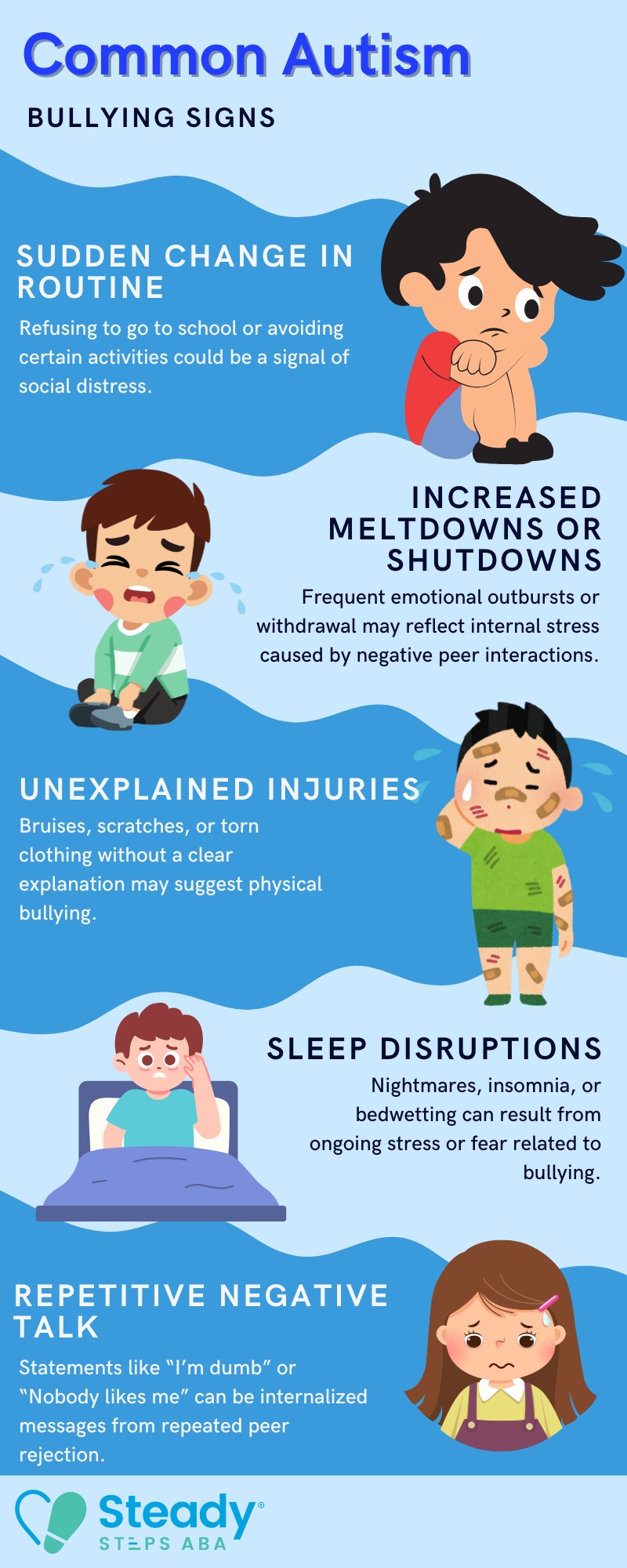Key Points:
- Children with autism are at a higher risk of being bullied due to differences in social communication and behavior.
- Bullying can have significant emotional and psychological effects on children with autism.
- Intervention strategies, including early detection and support, can help reduce the risk of bullying and provide coping mechanisms.
Bullying and autism are unfortunately closely linked, as children with autism spectrum disorder (ASD) often face increased vulnerability in social settings, particularly in schools. Bullying behaviors are frequently fueled by misunderstandings, stereotypes, and differences in communication styles.
For parents of children with autism, it can be heartbreaking to witness or hear about their child being bullied. Unfortunately, research indicates that this is a common occurrence, with over 60% of autistic individuals experiencing some form of bullying. Understanding why bullying happens and what can be done to prevent or address it is crucial in ensuring that children with autism receive the support and safety they need.
In this article, we’ll explore common bullying scenarios children with autism experience, the effects of bullying on them, and most importantly, how to help. As parents, teachers, and caregivers, we all play an essential role in creating a safer and more inclusive environment for those with autism.
How Common is Bullying for Children with Autism?
Children with autism are at a significantly higher risk of being bullied than their neurotypical peers. Research consistently shows elevated bullying rates among autistic students across school settings, with verbal harassment, social exclusion, and even physical aggression being common experiences.
This increased vulnerability is often linked to core traits of autism, such as difficulties with social communication, interpreting body language, and understanding unwritten social rules. Repetitive behaviors or unique interests may also draw negative attention. These factors can lead to social isolation, making it harder to form protective peer relationships and increasing the likelihood of being targeted.
While bullying can happen anywhere, it is especially prevalent in school environments, where children with autism may be more likely to be isolated or misunderstood by their peers. Early intervention and awareness are key in reducing these numbers and fostering inclusive environments that celebrate differences rather than punish them.
What are the Most Common Forms of Bullying Experienced by Children with Autism?
Bullying and autism are often intertwined through a variety of bullying behaviors that target the social and communication difficulties commonly associated with autism. These behaviors can range from verbal taunts to physical aggression. It’s crucial to recognize the specific types of bullying that children with autism may face, so we can address them effectively.
The most common types of bullying include:
1. Verbal Bullying
Verbal bullying is one of the most common forms of bullying that children with autism experience. It may include teasing, name-calling, mocking, or making fun of a child’s appearance, mannerisms, or difficulties in communication. Children with autism may have difficulty defending themselves verbally or understanding the social context of these insults, which makes them easy targets.
2. Social Exclusion
Social exclusion occurs when children with autism are deliberately left out of group activities, games, or social interactions. This can be particularly painful for children who are already struggling to form friendships and engage with their peers. The lack of social connections can lead to feelings of loneliness and isolation.
3. Physical Bullying
While less common, physical bullying is still a significant concern. This form of bullying may involve hitting, pushing, or other forms of physical aggression. Children with autism may struggle to defend themselves or may have difficulty identifying when they are being physically threatened, which makes them particularly vulnerable to physical bullying.
4. Cyberbullying
With the rise of technology, children with autism are increasingly at risk of cyberbullying. This can involve hurtful messages, rumors, or exclusion from online groups. Since children with autism may have difficulty navigating social media and online platforms, they might not always recognize when they are being targeted, which can lead to emotional harm.
How Does Bullying Affect Children with Autism?
The effects of bullying on children with autism can be profound, often extending well beyond the immediate incident. When a child is consistently bullied, it can affect their emotional and psychological well-being, which may also impact their social development and educational experience.
Here’s how bullying can affect children with autism:
1. Increased Anxiety and Depression
Children with autism who are bullied are more likely to experience heightened levels of anxiety and depression. The constant stress of being targeted can lead to fear and a sense of hopelessness, which may interfere with the child’s ability to function in day-to-day life. These mental health challenges can also affect academic performance and social relationships.
2. Decreased Self-Esteem
Experiencing bullying can take a significant toll on a child’s self-esteem. Children with autism may already feel different from their peers, and bullying can further reinforce feelings of inadequacy. This reduced sense of self-worth can affect the child’s social interactions and ability to trust others.
3. Social Withdrawal and Isolation
Repeated bullying can lead children with autism to withdraw from social activities, preferring isolation rather than facing further ridicule or exclusion. This social withdrawal can prevent them from building the social skills necessary for forming meaningful friendships and participating in group activities.
Signs Your Autistic Child Might Be Experiencing Bullying
Bullying can be hard to spot, especially when it comes to autistic children. Many children on the spectrum may struggle to express what’s happening or even recognize certain social behaviors as bullying. As a result, the signs may be subtle or mistaken for behavioral regression or anxiety.
Recognizing early red flags can help parents intervene quickly and support their child. Below are some common signs to look for if you suspect your autistic child might be facing bullying at school or in social settings.

Role of Teachers and School Staff in Preventing Bullying
Teachers and school staff play a key role in preventing bullying, particularly for vulnerable students like those with autism. By creating inclusive classrooms and setting clear behavior expectations, educators foster a respectful and safe environment. Promptly addressing bullying incidents ensures that all students are protected and supported.
Staff can also support prevention by teaching empathy and promoting peer understanding. Incorporating social-emotional learning (SEL) into the curriculum helps students develop skills like communication, emotional regulation, and respect for differences, fostering a more inclusive culture.
Regular training on identifying bullying and understanding the unique needs of autistic students ensures effective interventions. Teachers who are aware of the challenges autistic students face can implement strategies that make it easier to recognize and address bullying early, creating a safer school environment for everyone. Many of these challenges—like difficulty with change or unexpected disruptions—can also make social situations more overwhelming, which is explored further in Why Transitions are Tough for Autism and How to Help.
How Can Parents Help Prevent and Address Bullying and Autism?
As a parent or caregiver of a child with autism, it’s essential to be proactive in preventing bullying and addressing it if it occurs. Fortunately, there are several strategies that can help ensure your child feels safe, supported, and empowered. These include:
1. Teaching Social Skills and Self-Advocacy
One of the most effective ways to prevent bullying is to teach your child social skills and self-advocacy. Social skills training can help your child understand how to interact with peers in a positive and appropriate way, reducing the chances of social exclusion. Self-advocacy is also vital—helping your child understand their own rights and how to speak up when they are being mistreated can empower them to defend themselves in appropriate ways.
2. Encouraging Open Communication
It’s essential to maintain an open line of communication with your child about their experiences at school or in other social settings. Encourage your child to share any concerns they have about bullying or negative interactions with others. Creating a safe space for these conversations helps ensure that bullying is addressed early, before it becomes a more significant issue.
3. Work with Schools and Educators
Collaborating with schools is crucial in addressing bullying. Advocate for an environment that promotes inclusion, and ensure that teachers and staff are educated about autism and its related challenges. Work with the school to establish anti-bullying programs and ensure that they have a clear plan in place for addressing incidents of bullying when they arise.
4. Build a Strong Support System
In addition to school-based efforts, it’s important to surround your child with a strong support system. This can include therapists, family members, and friends who can provide emotional support and reinforce positive behaviors. Encouraging your child to engage in activities or groups that celebrate their strengths can also foster a sense of belonging and increase resilience against bullying.
Support Your Child with ABA Therapy in Maryland
At Steady Steps ABA, we specialize in ABA therapy in Maryland, offering individualized therapy that can help children with autism develop social skills, emotional regulation, and coping mechanisms for dealing with bullying. Through ABA therapy, children learn strategies to manage their behavior, communicate effectively, and understand social cues, all of which can reduce the likelihood of bullying.
If your child is struggling with social interactions or has experienced bullying, ABA therapy can provide the support they need to thrive in social situations. Our experienced team of therapists works closely with families to create tailored plans that promote positive development and foster self-confidence.
Contact us today to learn more about how ABA therapy can help your child overcome challenges related to bullying and autism in Maryland. Let’s work together to ensure that every child with autism has the tools they need to navigate social situations and build meaningful relationships.



